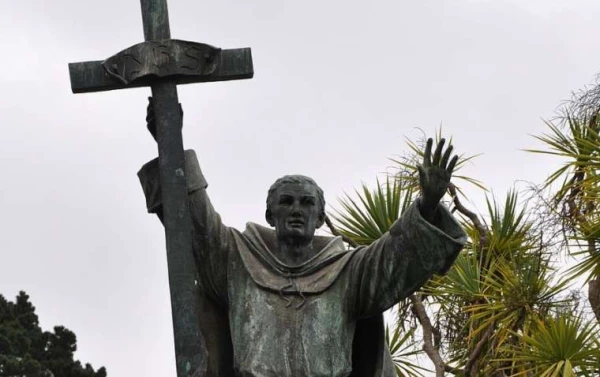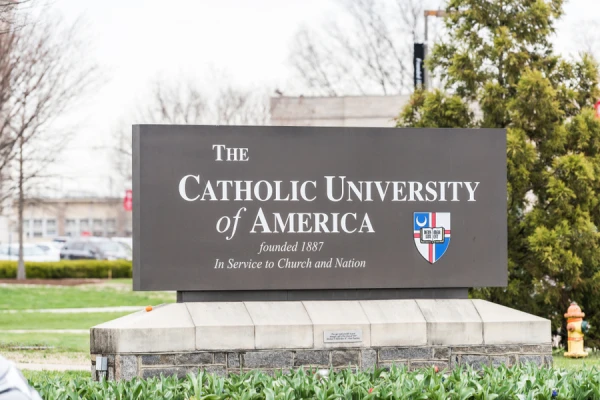
CNA Staff, Jun 30, 2020 / 02:24 pm (CNA).- Those who “slander” the legacy of St. Junipero Serra ignore his history of opposing colonial oppression and abuses of indigenous Americans, said Archbishop Jose Gomez of Los Angeles, praising the saint, whom he called the “spiritual founder” of Los Angeles.
“The real St. Junipero fought a colonial system where natives were regarded as ‘barbarians’ and ‘savages,’ whose only value was to serve the appetites of the white man. For St. Junipero, this colonial ideology was a blasphemy against the God who has ‘created (all men and women) and redeemed them with the most precious blood of his Son’,” Archbishop Gomez wrote in his June 29 column for Angelus News.
“He lived and worked alongside native peoples and spent his whole career defending their humanity and protesting crimes and indignities committed against them,” he said. “Among the injustices he struggled against, we find heartbreaking passages in his letters where he decries the daily sexual abuse of indigenous women by colonial soldiers.”
The archbishop called for the observance of St. Junipero Serra’s July 1 feast day as “a day of prayer, fasting and charity.”
Numerous statues of historic figures have been pulled down in recent weeks amid ongoing protests and riots throughout the country. While some protests have torn down the statues of Confederate figures as part of a call to end systemic racism, other statues have also been torn down from prominent locations, including one of George Washington.
In San Francisco’s Golden Gate State Park on June 20, a mob tore down statues of Junipero Serra, as well as Union general and U.S. President Ulysses S. Grant, and National Anthem author Francis Scott Key. In Los Angeles the same day, rioters pulled down a statue of Serra in the city’s downtown area.
Statues at Catholic churches and missions, including Southern California’s famous Mission San Juan Capistrano, have been relocated for fear of vandals.
Archbishop Gomez voiced understanding for “the deep pain being expressed by some native peoples in California.”
“The exploitation of America’s first peoples, the destruction of their ancient civilizations, is a historic tragedy. Crimes committed against their ancestors continue to shape the lives and futures of native peoples today. Generations have passed and our country still has not done enough to make things right,” he said.
Gomez said he believes protests over California history are important. He praised the city of Ventura’s model of respectful debate over the Serra monument with both indigenous leaders and Catholic representatives.
In other cases, he said, “it is clear that those attacking St. Junipero’s good name and vandalizing his memorials do not know his true character or the actual historical record.”
“He learned their languages and their ancient customs and ways,” Gomez said. “St. Junipero came not to conquer, he came to be a brother. ‘We have all come here and remained here for the sole purpose of their well-being and salvation,’ he once wrote. ‘And I believe everyone realizes we love them’.”
“Serious scholars conclude that St. Junipero himself was a gentle man and there were no physical abuses or forced conversions while he was president of the mission system,” said Gomez. “St. Junipero did not impose Christianity, he proposed it. For him, the greatest gift he could offer was to bring people to the encounter with Jesus Christ.”
During the eighteenth century, the saint founded nine Catholic missions in the area that would later become California. Many of those missions would go on to become the centers of major California cities. Serra helped to convert thousands of native Californians to Christianity and taught them new agricultural technologies.
Pope Francis canonized the Franciscan missionary in Washington, D.C. on Sept. 23, 2015.
Some critics have lambasted Serra as a symbol of European colonialism and said the missions engaged in the forced labor of Native Americans, sometimes claiming Bl. Serra himself was abusive.
“The sad truth is that, beginning decades ago, activists started ‘revising’ history to make St. Junipero the focus of all the abuses committed against California’s indigenous peoples,” said Gomez. “But the crimes and abuses that our saint is blamed for — slanders that are spread widely today over the internet and sometimes repeated by public figures — actually happened long after his death.”
At the time of Serra’s arrival in California, it was voluntary to live in the missions and only 10-20% of California’s native community joined Serra in these missions. St. Junipero died in 1784, but it wasn’t until 1851 when California’s first governor called for “a war of extermination” against the Native Americans and called in the U.S. Cavalry, according to Gomez.
“It is sadly true that corporal punishment was sometimes used in the missions, as it was practiced throughout late 18th-century society. It is also true that some natives died of diseases in the missions,” he said.
Gomez said the saint understood that “the souls of indigenous Americans had been darkened with bitterness and rage at their historic mistreatment and the atrocities committed against them.” He cited Serra’s defense of Kumeyaay attackers who in 1775 burned down the San Diego mission and tortured and murdered a priest who was a friend of Serra.
“St. Junipero was not outraged. He was concerned for the killers’ souls. He pleaded with authorities to have mercy,” said Gomez. Serra urged forgiveness of the killers after “some slight punishment.”
This would help teach the Christian rule “to return good for evil and to pardon our enemies,” Serra wrote.
“This may be the first moral argument against the use of the death penalty in American history,” said Gomez. “And St. Junipero was arguing against its imposition on an oppressed minority.”
Gomez rejected online petitions which compare the saint to Adolf Hitler and the missions to concentration camps.
“No serious historian would accept this, and we should not allow these libels to be made in public arguments about our great saint,” he said. While the missions had “many flaws,” he compared them to other communes and communitarian efforts of early American history.
“The missions were multicultural communities of worship and work, with their own governments and a self-sustaining economy based on agriculture and handicrafts,” said Gomez. “Living and working together, Natives and Spaniards created a new, mestizo (‘mixed’) culture reflected in the distinctive art, architecture, music, poetry, and prayers that came out of the missions.”
While society could eventually agree not to honor St. Junipero Serra or other figures in the past, said Gomez, “elected officials cannot abdicate their responsibilities by turning these decisions over to small groups of protesters, allowing them to vandalize public monuments.”
“This is not how a great democracy should function,” he said.
If you value the news and views Catholic World Report provides, please consider donating to support our efforts. Your contribution will help us continue to make CWR available to all readers worldwide for free, without a subscription. Thank you for your generosity!
Click here for more information on donating to CWR. Click here to sign up for our newsletter.




you still don’t understand. The riots and destruction aren’t to fight racism or inequality, they are a means to destroy the white men, hence people demand statues of white Jesus be teared apart.